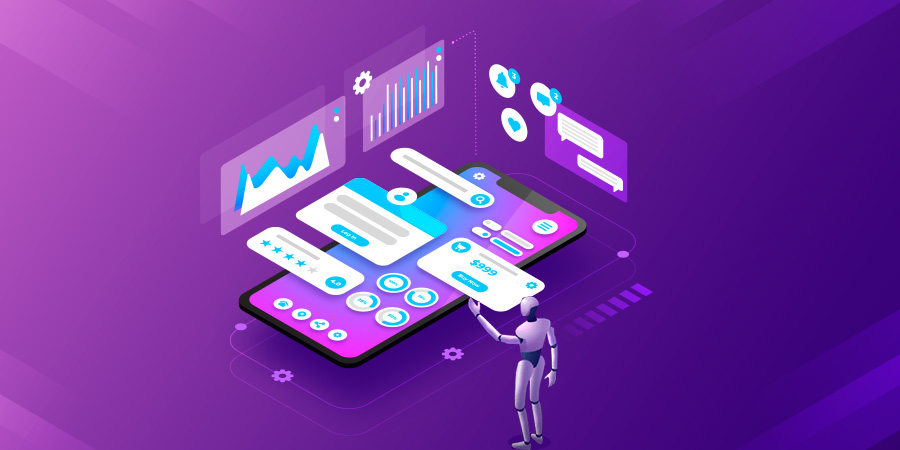How AI is Transforming the UX Design Landscape
2023 unfolds dynamic behavior of Artificial Intelligence (AI) in the tech industry.
Irrefutably, AI in UI/UX design has swiftly become the norm. It changes the way we design systems and products. While some people remain skeptical that AI can take away human jobs, UX designers and developers are reaping its advantages. Namely, AI helps them to recognize user behavior and needs. The outcomes? A vastly enhanced user experience.

AI for UX designs remains contentious. Some argue that AI reliability can lead to a design homogenization with different interfaces starting to look and function the same.
However, 62% of UI/UX designers are enthralled with Artificial Intelligence and are keen to savor the flavor that it would provide to the creative design process[i].
Considering such facts, it is essential to emphasize AI’s impact on UX designs.
In this article, we will discuss major instances of how AI has impacted UX designers and what holds for them in the future.
How Will Artificial Intelligence Influence UX Design?
AI can help personalize user experience. Designers, with AI, can develop customized experiences for every individual user, based on their unique behavior and preferences.
For instance, Facebook uses artificial intelligence and deep learning to add structure to its unstructured data. Its face recognition system, DeepFace, recognizes you in a photo shared on Facebook and suggests your name when someone tags you in their photo with you. Or, it automatically suggests tags with the person you often share photos with. Also, AI automatically catches and eradicates images that seem to be obscene.
Personalization can lead to enhanced satisfaction and engagement for users as they feel that the service or product is tailored to their interests and needs.
Also, AI improves the efficiency of UX design by automating tasks that might be time-consuming for humans.
For example, AI analyzes user data and determines trends and patterns that might not be instantly apparent to a human designer. AI can help designers define areas of a service or product that might need enhancement, permitting them to create more informed design decisions.
How Will AI Help UX Designers in 2023?
Businesses are in intense competition to build websites, apps, or other software with excellent user experience. AI can help them reach closer to their goals quicker than ever.
So, here are four ways AI can help UI/UX designers in 2023 and beyond:
1. Ideation and Brainstorming
The most difficult part of the design process is generating new ideas. AI can be of great help. It provides designers with a source of inspiration.
For instance, Dall-E, a deep learning model developed by OpenAI. You can get ample options for the image you create and give AI direction. Say, if you create a landing page of an e-commerce portal, Dall-E will provide you with different options to get a better design idea.
2. Generative Design
It is a kind of AI-assisted design that uses algorithms to produce multiple design solutions as per a set of constraints. This can help explore different design options and find new solutions to challenges and problems.
3. Collaboration and Automation
Artificial Intelligence (AI) can help designers to work and collaborate more efficiently. For example, Figma. Develop an iterative design flow with live collaboration that keeps designers in the loop whether working from office or remotely. Also, it tells which design is created by which team member. There are a lot of AI-powered Figma plugins to put designers at an absolute advantage. From converting iOS designs to Android designs, helping designers visualize ideas using prompts, and more; AI can make things easier for designers.
4. User Testing
It’s an essential part of the design procedure that consumes a lot of time. AI helps automate this process with user tests and provides designers with feedback.
Artificial Intelligence and the Future of UX Design
Irrefutably, the adoption of AI is increasing swiftly, as it presents many advantages and opportunities. It is predicted that, by 2035, AI technologies will enhance corporate profitability by 38% across 16 sectors[ii].
According to the product design company, Artefact[iii], there is a possibility that AI will transform UX designers into design curators rather than being the creators.
Designers will train their AI tools to solve design issues by creating models based on their preferences. Further, it is predicted that AI can make everyone a designer. At present, many design jobs are defined by social intelligence and creativity.
The first impact of AI will be that more non-designers will build their creative intelligence skills to reinforce their employability.
While industries such as transport, finance, and logistics are likely to be heavily influenced by AI, jobs depending on social skills and the human mind won’t be easily replaced.
Thus, AI will neither lower the importance of UX design nor will replace human UX designers.
Rather, AI will serve as a robust tool that UX designers can leverage to develop top-notch user experiences in the coming years.
If you need AI-based UX design solutions, drop us a line at [email protected] and we will take it from there.
References-
[i] Calibraint.com
[ii] Uxdesigninstitute.com
[iii] Artefactgroup.com
